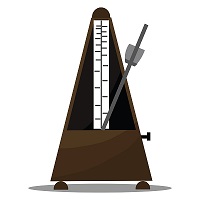
Metronome
The most important thing about a metronome is that you can hear it while you are playing. You need to hear the beat over your playing. If you can listen before you buy then do, but you can also use a headphone in one ear to hear it. Metronomes often have a number of other features that may be useful to intermediate players. Some subdivide the beats into eighth notes and beyond. A loud, simple metronome is the best initial purchase.

Music Stand
You need a music stand to practice effectively. Without a music stand it is difficult to have correct posture and see your music at the same time.
There are two general types of stands: folding ones and non-folding ones.
Folding stands start at less than $15. It is not necessary to buy anything better than this. The two disadvantages are that they are not as sturdy as other options and they are harder to write notes on the music. There are only a couple of manufacturers for non-folding stands. They start around $40. They are metal and quite heavy. The most well known brand is Manhasset. If you can afford one of these and will be playing mostly at home this is a great option.

Shoulder Rests
Most players use a shoulder rest. A shoulder rest helps to support the violin as you learn the mechanics of the instrument. They help make it easier to not grip the neck and allow an easier motion in shifting. There are many types of shoulder rests available. They start at about $40. This web page shows a few examples:
Shoulder Rest Examples.They start at about $40. The Kun shoulder rest is by far the most popular. It is adjustable and works for almost all body types. It is tried and true for starting the violin. There are look alikes for less money. This can make sense if it is a partial size violin and won't be used long. Once a student becomes more advanced they mightt choose to change to a different type of shoulder rest.

Tuners
There are two options for a tuner that are very popular now. One is a phone app and the other is a small clip on. For the phone there are many free apps available. They basically do the same thing, your preference in presentation is up to you. Some have a needle showing when in tune and I can even thinkn of one that smiles when in tune. For clip on tuners the Snark tuners are affordable and easy to use. In almsot all tuners a note name is presented. An arrow to the left means it is flat and an arrow to the right means it is sharp. It is almost impossible to miss with these. Bass players you may find that some tuners do not do well with the low E string. The Snark tuners do seem to work well. If your tunerr does not work you can be taught to use the harmonic on that string.